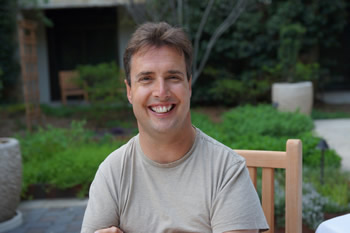By Corbin Black
 Dr. Alain Laederach is an Associate Professor at the University of North Carolina, Chapel Hill, where his lab studies how RNA structure is related to function and disease. They have been using a combination of computational and experimental techniques to model different structural elements caused by single nucleotide variants, otherwise known as “riboSNitches”. Originally from Switzerland, Alain completed a chemical engineering degree before coming to Iowa State University, where he earned a PhD in bioinformatics and computational biology, co-supervised by Dr. Peter J. Reilly and Dr. Amy H. Andreotti. He joined Dr. Russ Altman’s lab at Stanford University as a Postdoctoral Fellow, during which time his mentor gave him advice that Alain now passes on to his students: “always have a ‘driving biological problem.’ In the computational space we love to develop big hammers with even bigger computers. Make sure there are some nails to hit with your hammer that have some relationship to biology people care about.”
Dr. Alain Laederach is an Associate Professor at the University of North Carolina, Chapel Hill, where his lab studies how RNA structure is related to function and disease. They have been using a combination of computational and experimental techniques to model different structural elements caused by single nucleotide variants, otherwise known as “riboSNitches”. Originally from Switzerland, Alain completed a chemical engineering degree before coming to Iowa State University, where he earned a PhD in bioinformatics and computational biology, co-supervised by Dr. Peter J. Reilly and Dr. Amy H. Andreotti. He joined Dr. Russ Altman’s lab at Stanford University as a Postdoctoral Fellow, during which time his mentor gave him advice that Alain now passes on to his students: “always have a ‘driving biological problem.’ In the computational space we love to develop big hammers with even bigger computers. Make sure there are some nails to hit with your hammer that have some relationship to biology people care about.”
Dr. Laederach and his team are currently studying how structure in 5’ UTRs with multiple upstream open reading frames (uORFs) controls translation. “As someone who has analyzed a lot of RNA-seq data and generically used the term ‘expression’ without specifying RNA or protein,” he said, “this work has really made me rethink how we interpret transcriptomic results. I think this is especially true in the field of precision medicine, where a vast majority of disease-associated mutations map to non-coding but often transcribed regions of the genome. The incredible work of the RNA community in understanding translation initiation is likely going to change the way we interpret rare variation in patient genomes.”
“Always have a ‘driving biological problem.’”
Dr. Laederach had practical advice for trainees: “Become proficient in data analysis and making nice graphics. If you use Excel, fine, but just don’t make graphs with it! Same thing with powerpoint—just use Inkscape if you don’t want to buy Illustrator.” He then added, “Being a member of the RNA society and attending the meetings give you one week during the year where you can really immerse yourself in the current state of the art across the field.” Dr. Laederach has been an enthusiastic participant of RNA meetings, involved in a wide range of activities—from event organization to research presentation to prolific RNA Society-related Twitter use.
The annual Society meetings have also shaped his lab’s research. One key example came at the 2015 RNA Society Meeting in Madison, Wisconsin. He explained, “A post-doc in my lab, Amanda Solem, was about to present our structural model for translation regulation. At the opening reception she met with a friend of hers, Angie Hiliker (University of Richmond). Amanda asked Angie if she could think of any elements that control translation, and Angie mentioned the importance of uORFs and asked if there were any in the alternatively spliced 5′ UTRs. That night I had the whole lab mapping uORFs in 5’ UTRs and of course we found multiple ones. Later we tested these uORFs and found some of them to be functional, and this allowed us to refine an even more accurate computational model using Kozak sequence strength.” He added, “Of course the polished “story line” is far more linear and mentions the Kozak sequence in the introduction!”
Naturally, Dr. Laederach’s favorite RNAs are riboSNitches. He can be found on Twitter @alaederach. At the next RNA or computational biology meeting, you just might be treated to an entertaining and witty Twitter feed courtesy of @alaederach and his nemesis, the infamous @RiboHipster. Dr. Laederach humorously professed, “I actually have no idea who s/he is, but they are clearly much smarter than me. Every year I try and find out who @RiboHipster is at the meeting but I have yet to meet them. If you search my twitter history, you’ll dig up some pretty epic banter!”
